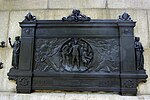Garden Bridge
The Garden Bridge project was an unsuccessful private proposal for a pedestrian bridge over the River Thames in London, England. Originally an idea of Joanna Lumley, and strongly supported by then-Mayor of London, Boris Johnson, the designer Thomas Heatherwick worked with Arup Group on a proposal by Transport for London (TfL) for a new bridge across the Thames between Waterloo Bridge and Blackfriars Bridge. The proposed concrete, steel, cupronickel clad structure was intended to carry pedestrians, with no cycles or other vehicles. It was to have been located some 200 metres (660 ft) from Waterloo Bridge and 300 m (980 ft) from Blackfriars Bridge, and have included some areas of planting. The project was to include a commercial building, built on former green space at the southern end of the bridge. The bridge was intended to be funded by raising over £140 million of private money (including taxpayer funding through charitable gift aid) and £60 million of promised public money, of which £30m was from Transport for London (£20m of this to be repaid over 55 years) and £30m from the Department for Transport, adding up to projected funding of over £200m. In January 2017, the trustees of the prospective owner of the bridge, the Garden Bridge Trust, stated that costs would "substantially exceed" an earlier revised total of £185m and, in April 2017, a report by Margaret Hodge MP concluded, on the basis of the Garden Bridge Trust's own evidence, that the cost would be over £200m.If built, it was proposed that the bridge would have been open from 6am to midnight, with closures for the preparation for and holding of up to 12 private commercial events per year to raise funds for its maintenance. A planning condition required annual maintenance costs to be guaranteed by a third party and it was expected that this would be the Greater London Authority. The annual maintenance costs were variously estimated at between £2m and £3.5m, before allowing for the repayment of loan capital and interest.In July 2016 preparatory work for the bridge was halted and the Garden Bridge Trust put contractors on standby to allow for a financial review and because they had not cleared outstanding issues such as securing legal rights to the land on either side of the river, despite signing a contract for construction of the bridge in January 2016. In September 2016, Sadiq Khan, Mayor of London, announced a formal review by Margaret Hodge of the procurement processes in relation to the bridge project and its value for money. In October 2016, the National Audit Office reported on procurement issues and perceived value for money for that part of the cost of the project which was being met by funds (£30m) from the Department for Transport. In January 2017, the trustees of the Garden Bridge Trust (the limited company behind the project) said they were unable to conclude that the trust was a going concern. In February 2017, the Charity Commission for England and Wales found the financial management of the trust to be satisfactory, albeit with criticisms as to the trustees' approach. The subsequent report by Margaret Hodge MP was highly critical of the plan, its procurement, its cost, the risk to public funds, and lack of value for money.The Garden Bridge Trust formally announced on 14 August 2017 that it would be ending the project and that the Garden Bridge Trust itself would be wound up in accordance with the Companies Acts. The failed project cost £53m, including £43m of public money.
Excerpt from the Wikipedia article Garden Bridge (License: CC BY-SA 3.0, Authors).Garden Bridge
Victoria Embankment, London Covent Garden
Geographical coordinates (GPS) Address Nearby Places Show on map
Geographical coordinates (GPS)
| Latitude | Longitude |
|---|---|
| N 51.5097 ° | E -0.1129 ° |
Address
HQS Wellington (Honourable Company of Master Mariners)
Victoria Embankment
WC2R 2PN London, Covent Garden
England, United Kingdom
Open on Google Maps










